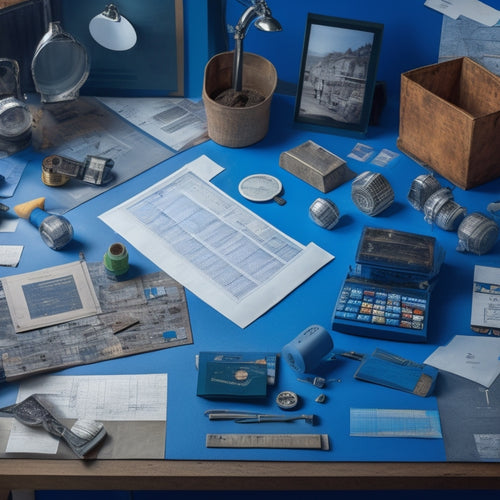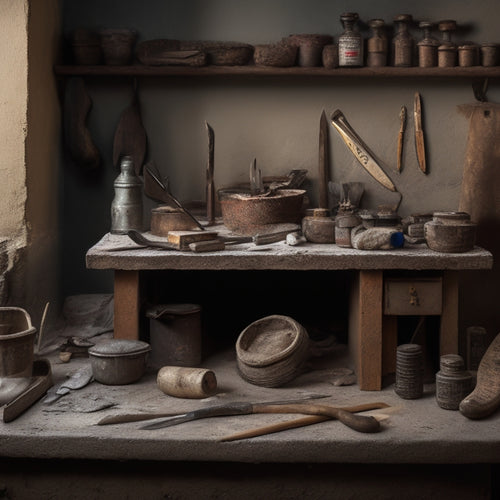
Calculate Materials for Your Small Renovation Projects
Share
When calculating materials for your small renovation project, start by understanding concrete requirements, including type selection and curing methods. Next, accurately measure the area and depth of each room, accounting for obstructions and irregularities. Convert units of measurement as needed, and calculate concrete volume using the formula V = L × W × H. Don't forget to factor in waste and shrinkage, adding 10-15% to your total quantity. As you assemble your material list and budget, precise calculations will help you avoid costly mistakes and stay on track – and there's more to take into account in ensuring a successful project.
Key Takeaways
• Accurately measure dimensions, including length, width, and thickness, to calculate concrete volume and material needs.
• Consider concrete type, curing methods, and structural integrity to ensure project stability and compliance with building standards.
• Calculate material quantities by determining volume, accounting for mix design, reinforcement, and wastage allowance, and converting units of measurement.
• Factor in waste and shrinkage rates, typically 10-15%, to ensure sufficient materials and minimize environmental impact.
• Review calculations, create a detailed material list, and prepare tools and budgeting strategies to consolidate information for the renovation project.
Understanding Concrete Requirements
When planning a renovation project, you'll need to determine the amount of concrete required to secure structural integrity and stability. This involves selecting the right concrete type for your project, as different types have distinct properties and uses.
For instance, high-strength concrete is ideal for load-bearing structures, while fiber-reinforced concrete is better suited for projects requiring high durability.
You'll also need to take into account curing techniques, which greatly impact the concrete's final strength and quality. Proper curing involves maintaining the right temperature, humidity, and moisture levels to prevent defects and guarantee ideal hydration.
This can be achieved through various methods, including membrane curing, steam curing, or using curing compounds.
Understanding the different concrete types and curing techniques available will enable you to make informed decisions and guarantee your renovation project meets the required standards.
Calculating Concrete Volume Needs
When calculating concrete volume needs for your renovation project, you'll need to determine the dimensions of the concrete slab, including its length, width, and thickness.
You'll then use these values to plug into the volume calculation formula, which is typically expressed as V = L × W × H.
Concrete Slab Dimensions
You'll need to determine the concrete slab's length, width, and thickness to calculate the volume of concrete required for your renovation project. These dimensions will affect not only the amount of concrete you'll need but also the slab's structural integrity.
| Dimension | Description |
|---|---|
| Length | The longest side of the slab, typically measured in feet (ft) |
| Width | The shorter side of the slab, also measured in feet (ft) |
| Thickness | The depth of the slab, usually measured in inches (in) |
| Slab Reinforcement | Type and quantity of rebar or fiber mesh used for added strength |
| Curing Techniques | Methods used to control temperature and moisture for ideal curing |
When determining the slab's dimensions, consider factors like load-bearing capacity, soil conditions, and drainage. For example, a thicker slab may be necessary for areas with high traffic or heavy equipment. Additionally, slab reinforcement and curing techniques will impact the slab's strength and durability. By accurately calculating the concrete slab's dimensions, you'll be able to specify the right materials and guarantee a successful renovation project.
Volume Calculation Formula
To calculate the volume of concrete needed for your renovation project, multiply the length, width, and thickness of the slab to determine the total volume in cubic feet. This calculation is essential for accurate volume estimation, making sure you order the right amount of materials and avoid waste.
For a rectangular slab, the formula is:
Volume (in cubic feet) = Length (in feet) × Width (in feet) × Thickness (in feet).
For example, if your slab is 10 feet long, 8 feet wide, and 4 inches thick, the calculation would be:
Volume = 10 × 8 × (4/12) = 26.67 cubic feet.
When calculating the volume, consider the material efficiency of your concrete mix. A well-designed mix can reduce waste and save you money. Make sure you're using the best mix design for your project, taking into account factors like compressive strength, workability, and finishability.
Mixed Concrete Quantity
Your renovation project's mixed concrete quantity depends on the calculated volume of concrete needed, which you'll use to determine the number of batches required.
To get an accurate calculation, you'll need to take into account the following factors:
-
Volume of the concrete slab or structure: Calculate the length, width, and height of the area that needs concrete. Multiply these dimensions to get the total volume in cubic feet or meters.
-
Mix design: The type of mix design you choose will affect the concrete's density and volume. A high-strength mix, for example, may require more cement and less aggregate, resulting in a denser concrete.
-
Reinforcement options: If you're using reinforcement materials like rebar or fiber mesh, you'll need to account for the space they occupy in the concrete.
- Wastage and overage: Add 10-15% to your total volume calculation to account for spills, uneven surfaces, and other imperfections.
Measuring Area and Depth
When measuring area and depth for your renovation project, you'll need to take precise room dimensions to guarantee accurate calculations.
You'll want to record the length, width, and any obstructions or irregularities in each room.
Room Dimensions Matter
Accurate room dimensions are essential for calculating materials, as they directly impact the quantity of flooring, paint, and other essentials needed for a successful renovation project. You can't afford to make assumptions or rely on rough estimates, as this can lead to costly mistakes and delays. To guarantee dimension accuracy, take the time to carefully measure your room's layout.
Here are some key considerations to keep in mind:
-
Measure each wall: Record the length and width of each wall, including any obstructions like doors, windows, or built-in shelving.
-
Note any irregularities: Take note of any irregularities in the room's shape, such as alcoves, recesses, or curved walls.
-
Account for corners: Don't forget to measure the dimensions of any corners, as these can affect the layout of your flooring and other materials.
- Double-check your measurements: Verify your measurements by re-checking them against your room's layout to guarantee accuracy.
Depth Calculation Tips
With room dimensions in hand, you're now ready to calculate the area and depth of your renovation project, which involves measuring the space where materials will be applied.
To accurately measure depth, you'll need to employ effective depth measurement techniques. Start by identifying the areas that require materials, such as walls, floors, and countertops.
Next, take precise measurements of these areas using a tape measure or laser level. Record these measurements to guarantee accuracy.
When measuring depth, consider factors like wall thickness, flooring underlayment, and countertop overhangs. You can also utilize depth estimation tools, such as online calculators or mobile apps, to streamline the process.
However, be sure to double-check your calculations to avoid errors. By combining precise measurements with reliable depth estimation tools, you'll be able to accurately calculate the materials needed for your renovation project.
This attention to detail will save you time, money, and frustration in the long run.
Converting Units of Measurement
Converting between units of measurement is an essential step in guaranteeing that your renovation project's material calculations are precise, as even small discrepancies can add up to significant costs.
You'll likely encounter different units of measurement when working with various materials, suppliers, and measurement tools. To avoid errors, it's vital to master unit conversion.
Here are some common unit conversions you'll need to know:
-
Length: 1 foot = 12 inches = 0.3048 meters
-
Area: 1 square foot = 144 square inches = 0.0929 square meters
-
Volume: 1 cubic foot = 1728 cubic inches = 0.0283 cubic meters
- Weight: 1 pound = 16 ounces = 0.4536 kilograms
When performing unit conversions, make certain to use reliable measurement tools, such as digital calipers or tape measures, to guarantee accuracy.
Double-check your calculations to avoid mistakes that can impact your project's budget and timeline.
Accounting for Waste and Shrinkage
You must also consider the inevitable losses that occur during material handling and installation, including waste and shrinkage, to guarantee your calculations accurately reflect the total amount of materials needed for your renovation project.
These losses can add up quickly, especially when working with materials that are prone to damage or have complex cutting requirements. To account for waste and shrinkage, you'll need to factor in a percentage of excess material into your calculations. A general rule of thumb is to add 10-15% to your total material quantity to make sure you have enough to complete the job.
Effective waste management and material efficiency are essential in reducing the environmental impact of your project and minimizing unnecessary expenses. By incorporating waste reduction strategies, such as optimizing cutting patterns and reusing materials, you can minimize the amount of excess material required.
Be sure to research the specific waste and shrinkage rates associated with your materials and adjust your calculations accordingly. This attention to detail will help you avoid costly mistakes and make certain a successful renovation project.
Putting It All Together
Now that you've accounted for all the essential factors, it's time to consolidate your calculations and create a detailed material list for your renovation project. This is where you'll bring together all the numbers and details to guarantee you're well-prepared for the task ahead.
Here's a step-by-step guide to help you put it all together:
-
Review your calculations: Double-check your measurements, quantities, and waste calculations to guarantee accuracy.
-
Create a thorough material list: Write down every material you need, including quantities and specifications.
-
Develop a tools checklist: Make a list of all the tools you'll need to complete the project, including rented or borrowed equipment.
- Establish budgeting strategies: Determine how you'll allocate your budget, prioritize expenses, and manage contingencies.
Frequently Asked Questions
Can I Use a Calculator App on My Phone for Calculations?
You can definitely use a calculator app on your phone for calculations.
In fact, many calculator apps offer advanced features that can simplify complex math problems.
With mobile convenience, you can access these features anywhere, anytime.
Look for apps that offer scientific notation, trigonometric functions, and unit conversions.
These features will help you tackle even the most challenging calculations with ease.
How Do I Determine the Correct Type of Concrete for My Project?
Imagine yourself standing on a construction site, surrounded by mixers and cement trucks.
To determine the correct type of concrete for your project, you'll need to take into account the project requirements.
Will it be exposed to harsh weather or heavy foot traffic?
Do you need high strength, low shrinkage, or specific color retention?
Research different concrete types, such as ready-mix, high-strength, or fiber-reinforced, to guarantee you choose the right one for your project's unique demands.
What Safety Precautions Should I Take When Working With Concrete?
When working with concrete, you'll need to prioritize concrete safety by taking essential precautions.
First, wear personal protective equipment (PPE) like gloves, safety glasses, and a dust mask to prevent skin and eye irritation.
Guarantee you're wearing long sleeves, pants, and closed-toe shoes to protect your skin from alkaline burns.
Additionally, work in a well-ventilated area to avoid inhaling dust and fumes.
Always follow the manufacturer's instructions and mix concrete in a designated area to minimize risks.
Can I Mix and Pour Concrete in Cold or Wet Weather?
When you're planning to mix and pour concrete, you'll want to take into account the weather impact on your project.
In cold or wet weather, concrete freezing can occur, weakening its structure. You'll need to take precautions to make certain the concrete cures properly.
Check the weather forecast beforehand and avoid pouring in temperatures below 40°F (4°C) or during heavy rain.
If you must pour in cold weather, use accelerators or heated mixing water to speed up the curing process.
Are There Any Eco-Friendly or Sustainable Concrete Options Available?
You're likely wondering if there are eco-friendly or sustainable concrete options available. The answer is yes! You can explore sustainable alternatives that reduce the environmental impact of traditional concrete.
One approach is using recycled aggregates, which can replace up to 30% of virgin materials. This not only reduces waste but also decreases the energy required for production.
Look for suppliers that offer recycled concrete aggregates or consider using supplementary cementitious materials like fly ash or slag to minimize your carbon footprint.
Conclusion
You've mastered the art of calculating materials for your small renovation projects. Now, put it into practice.
Imagine you're resurfacing a 10x10 foot patio with a 4-inch thick concrete slab. Using the formulas, you calculate you need approximately 1.48 cubic yards of concrete.
Don't forget to account for 10% waste and shrinkage, adding an extra 0.15 cubic yards to your total.
With this precise calculation, you'll avoid costly mistakes and guarantee a successful project.
Related Posts
-

5 Best Home Renovation Project Timeline Checklists
You're looking for a clear understanding of the timeline for your home renovation project. A good place to start is w...
-

Stucco Tool Kit Checklist for Home Renovation
You'll need a thorough stucco tool kit to guarantee a successful home renovation, as the right tools can make all the...
-

Budget-Friendly Materials for Your Home Renovation Needs
As you initiate your home renovation, you're enthusiastic to find budget-friendly materials that fit your vision with...


